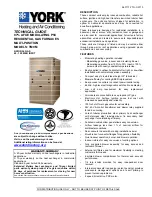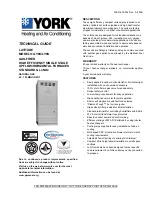
506794-01
Page 4 of 16
Issue 1243
Non-Suspended Horizontal Installation
To support the furnace from below, set the furnace on non
-combustible material suitable to support the weight of the
unit. Using a carpenter’s level, check furnace in at least
two directions. To make adjustments, use shims of non-
combustible material. Seven inches minimum clearance
between the bottom of the flue pipe and combustible
material is required. Installation on a combustible floor
requires a 1” clearance from the floor.
Suspended Horizontal Installation
Before suspending the furnace, remove the knockouts in
the top of the panel at the warm air discharge and at the
blower panel. Use 3/8” threaded rods cut to the desired
length. Use one flat washer and two nuts on each rod.
Place one nut and one flat washer on the inside of the unit
and one nut on the outside (see Figure 1). The outside nut
serves as the locking nut. Level the unit using the inside
nuts.
Rod
Nut
Top of
Furnace
Washer
Nut
Figure 1. Hangar Rod Installation
Horizontal Installation Reversing the Air Flow
This furnace is assembled to discharge warm air out
the left side (when viewed facing the burner side of the
furnace). If installation requires that the flow be reversed,
follow these steps:
1. Rotate the furnace 180° so that the warm air is
discharged out the right side.
2. Remove the oil burner and the screws securing the
burner mounting plate. Rotate the burner mounting
plate 180° and reattach with screws. Remount the
burner in the upright position.
3. Remove the screws holding the limit control in place.
Relocate the limit control to the top side of the front
panel using the knockout hole provided.
Figure 2. Minimum Clearances - Horizontal
Installations
E
D
B
G
F
A
C
C
Supply
Return
Supply
Return
Front View
Top View
84 - 125
Front Flue
84 - 125
Rear Flue
A
Top
1”
4”
B
Duct
1”
6”
C
Sides
1”
6”
D
Bottom
1”
4”
E
Rear
1”
24”
F
Front
24”
24”
G
Flue
7”
9”
Counterflow Installation
This furnace is assembled to discharge warm air out the left
side (when viewed facing the burner side of the furnace).
To convert to counterflow:
1. Rotate the furnace so the return is on top and the
supply is on bottom.
2. Remove the oil burner and the screws securing the
burner mounting plate. Rotate the burner mounting
plate 90° clockwise and reattach the screws into the
heat exchanger. Remount the burner.
3. Refer to Figure 3 for minimum clearances required.
When installing a counterflow unit on combustible
flooring, a combustible floor base must be used.
See
Figure 4 for more information on using a combustible floor
base kit.


































